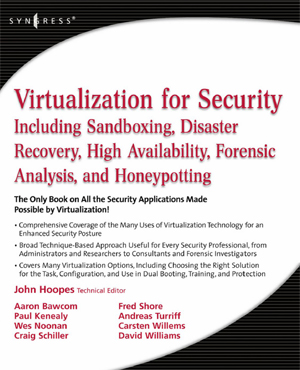 After having this on my shelf and desk for what seems to be an eternity, I have finally managed to finish Virtualization for Security: Including Sandboxing, Disaster Recovery, High Availability, Forensic Analysis and Honeypotting. Despite having one of the longest titles in the history of publishing, it is justified as the book covers a lot of topics and subject matter. The chapters are:
After having this on my shelf and desk for what seems to be an eternity, I have finally managed to finish Virtualization for Security: Including Sandboxing, Disaster Recovery, High Availability, Forensic Analysis and Honeypotting. Despite having one of the longest titles in the history of publishing, it is justified as the book covers a lot of topics and subject matter. The chapters are:
- An Introduction to Virtualization
- Choosing the right solution for the task
- Building a sandbox
- Configuring the virtual machine
- Honeypotting
- Malware analysis
- Application testing
- Fuzzing
- Forensic analysis
- Disaster recovery
- High availability: reset to good
- Best of both worlds: Dual booting
- Protection in untrusted environments
- Training
Firstly, if you’re not security focused don’t let the title put you off picking this up. While some of the chapters are infosec specific a lot of the material is more general and could be applied to any IT system, the chapters on DR, HA and dual booting are good examples of this.
Undoubtedly the range of content in the book is one of it’s biggest draws, I felt like a kid in a sweet shop when I first read the contents and had a quick flick through, I just couldn’t decide where to start. This feeling continued as I read through each chapter, different ideas and options that I hadn’t tried were mentioned and discussed, resulting in me scribbling another note to my to-do list or putting the book down entirely while I turned my lab on to try something.
The real gem of information that I found in the book was under the sandboxing chapter, which was one of the topics that persuaded me to purchase the book in the first place. Considering that one of the books authors is Cartsten Willems, the creator of CWSandbox it shouldn’t be too surprising that this chapter covers sandboxing well. The chapter also covers creating a LiveCD for sandbox testing, while very useful for the context it was explained in, it was one of several parts to the book where by brain started to hurt from an overload of possible uses.
As you might have already guessed, the range of topics is also one of the books biggest weaknesses. There just isn’t enough space to cover each topic in sufficient depth. I felt this most in the topics that I’m more proficient with, while the Honeypotting chapter does a great job of explaining the technology and methodology but I was left wanting more. The disappointment from this was lessened on topics that I have less (or no) experience with as all the material was new.
Overall I really liked the book, it provides an excellent foundation to the major uses of virtualisation within the infosec field, and perhaps more importantly leaves the reader (at least it did with me) enthusiastic to research and test beyond the contents of the book as well. The material won’t help you become an expert, but if you want to extend your range of skills there are definitely worse options available.
–Andrew Waite